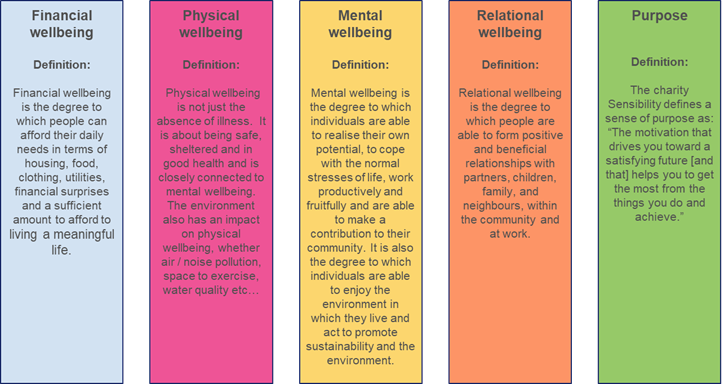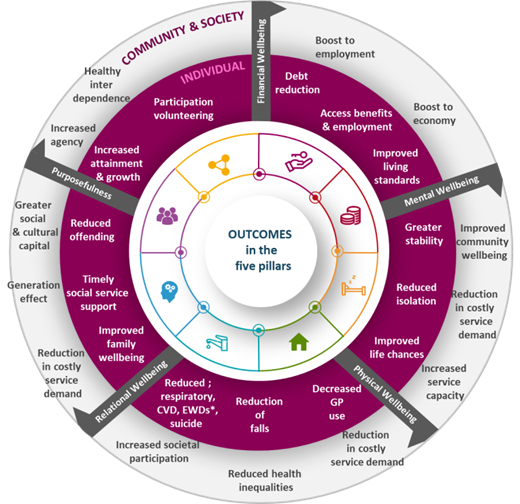
A framework for measuring social wellbeing
When we talk about social wellbeing we are thinking about changes in the lives of individuals, families and communities. Those changes are often described as outcomes, and may represent change for the better or simply enabling good things to stay the same.
For Sonnet, wellbeing is an outcome. We want to enrich people’s lives so that they prosper physically, mentally and socially. True wellbeing is derived from a complex recipe of ingredients comprising environmental, social and economic factors.
Introducing the five pillars of wellbeing
Drawing on these themes, Sonnet ( formerly Bates Wells A&I) has developed the five pillars of wellbeing, drawn and adapted from original work by Webb Trust and Carnegie UK Trust. The five pillars, illustrated below, are financial, physical, mental, relational and purpose.
They provide a lens through which we can understand an individual’s life story and a framework to consider holistically the needs and outcomes an individual is experiencing across: financial, physical, mental, relational and purposeful wellbeing. The individual’s outcomes can then be extended through each pillar to look at outcomes for the community and society as a whole. That is, the pillars provide a broad and helpful framework to determine how an individual / family / group struggles or thrives in their home and in their life. The interdependencies between them mean that a lacking in one area of wellbeing can often have a knock-on or toppling effect on one or more of the other pillars – resulting in poor social outcomes.

Next Steps
When assessing the wellbeing outcomes of our actions the next step is to find measures to value the pillars that allow us to assess the social impact of an intervention on wellbeing e.g. increased employment and data that can evidence this such as success rates of employability programmes, which can bring both financial wellbeing and purpose. The wheel below demonstrates possible outcomes in each of the five pillars.
The Hyde Group (Housing Association)
The diagram on the right reflects the outcomes measured in a project commissioned for Hyde Housing Association, we adopted the framework and used a wide array of methods during the research process to bring life to the five pillars and the stories of those living in social housing and those without social housing. The findings were published under ‘The Value of a Social Tenancy’.

Frameworks for measurement are useful in focusing our thoughts on what can be achieved. If you are looking at wellbeing measures, do the five pillars work for you? Or do they need adapting for your particular needs?
Do get in touch and tell us what you decide!






